| Tweet | Follow @OphirGottlieb |  |  |

This visualization is provided by:
Capital Market Laboratories: Get Notified When CML Light Goes Live
AAPL is trading $96.18, down 2.6% with IV30™ up 12.8%. The Symbol Summary is included below.
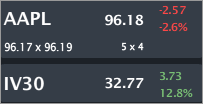
Provided by Livevol
Conclusion
This is an earnings preview that will focus on risk compared to the past (via the options market), the metrics that AAPL will be judged on in the earnings release and some trends and valuation measures that may surprise you. We'll even get down to the effective tax rate trend... Yeah, let's get into AAPL... Right now.
Let's start with the YTD stock return chart. While the S&P 500 has gone negative this year as of today, AAPL is up 20%. Not too shabby for the largest company in the world (by market cap).
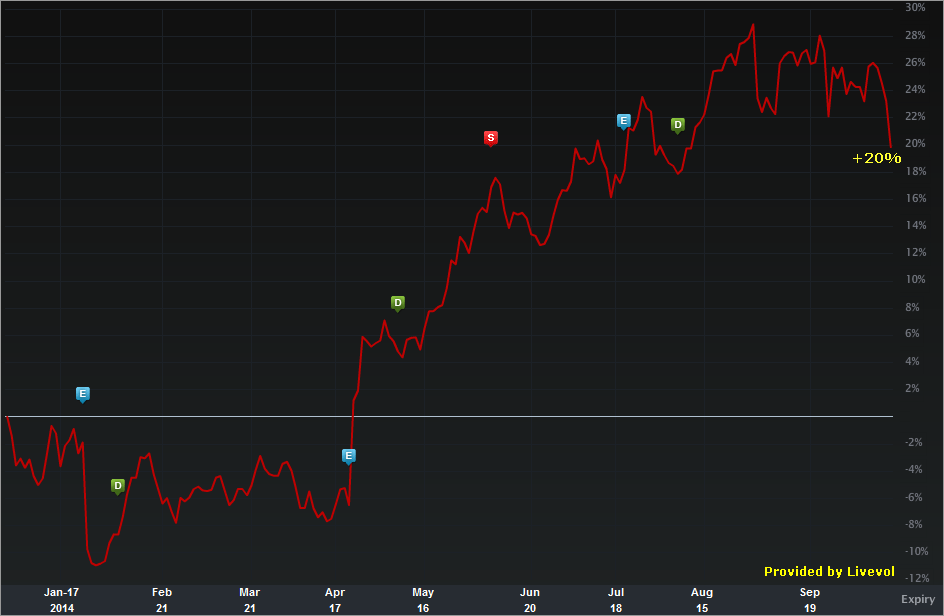
Provided by Livevol
Now let's turn to the measures that will drive the earnings reaction. Obviously there is the top line (revenue) and the bottom line (net income), but those two numbers have a lot of room in between that will be focused on.
Revenue (TTM) to Earnings Margin % Trend
AAPL revenue growth has been truly unprecedented (the blue bars), hitting ~ $180B in the trailing-twelve-months. But, if we listen to that whisper, or even better look at a big red line, we can see that margins have been deteriorating at a non-trivial rate. That number (the earnings margin%) will be a hyper focus in this earnings report.
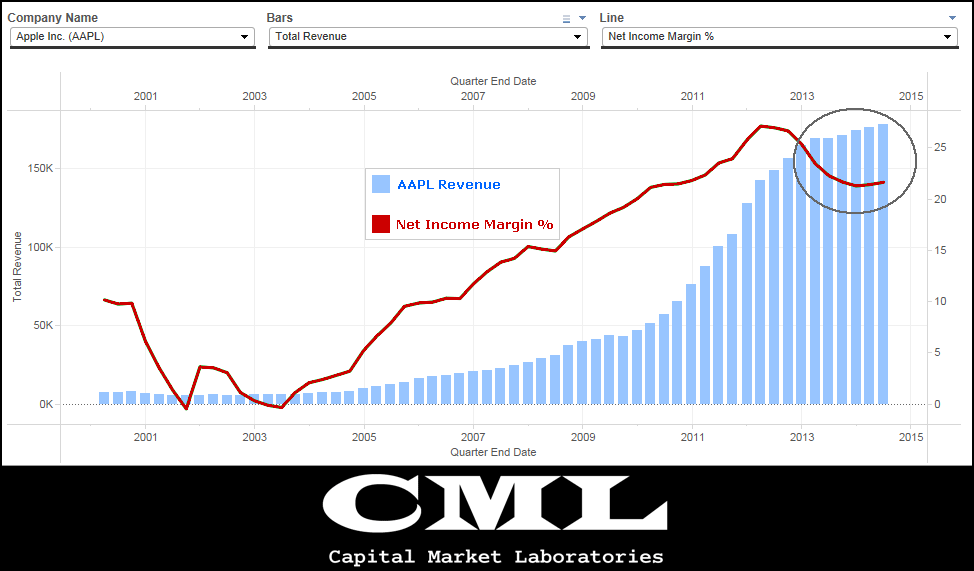
------> Do this analysis yourself: Capital Market Laboratories
Revenue (TTM) to Gross Margin %
Net income margin % is composed of many different sub margins. For AAPL (and most companies), gross margin % is a key. i have included the two-year chart to hyper focus on the trend that shows a decline in gross margin % for AAPL from over 40% (this was a "magical number for AAPL for along time) to now 38.40%. The market "forgave" AAPL for dipping below 40% given the extraordinary revenue and earnings growth, but that number -- gross margin % is still a huge focal point of every earnings release for this company.
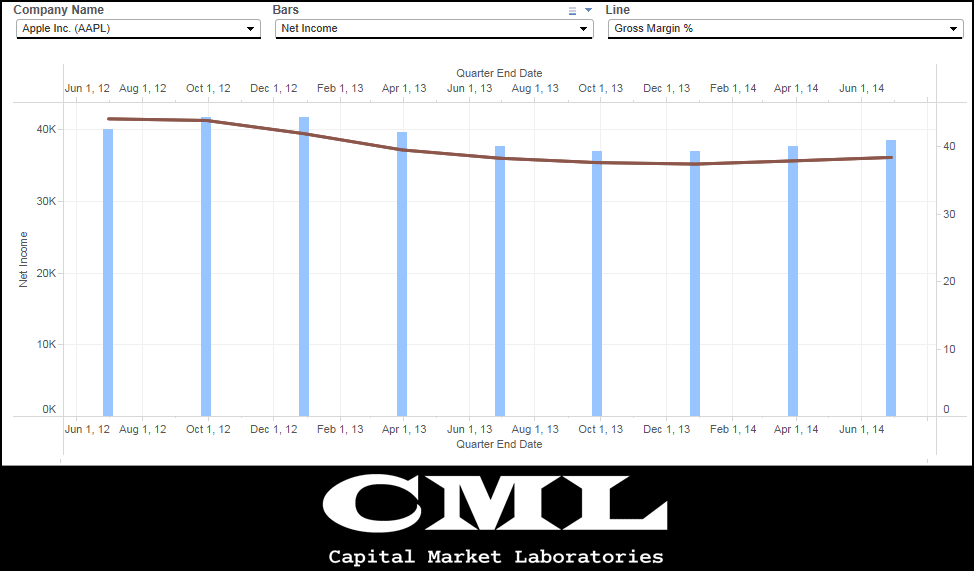
Valuation: Price to Sales
We can see that AAPL's valuation relative to sales has been dipping over the long-term,which is normal and correct as the firm moved out of crazy growth mode,to just crazy huge company mode. one thing to note, though, if we focus on the short-term, AAPL's P/S has jumped 50% from ~10 to now ~15 in two-years. people have gotten on board with Tim Cook and crew (post Steve Jobs). That higher valuation does in fact reflect an expectation of accelerating growth. iPhone 6 etc better deliver.
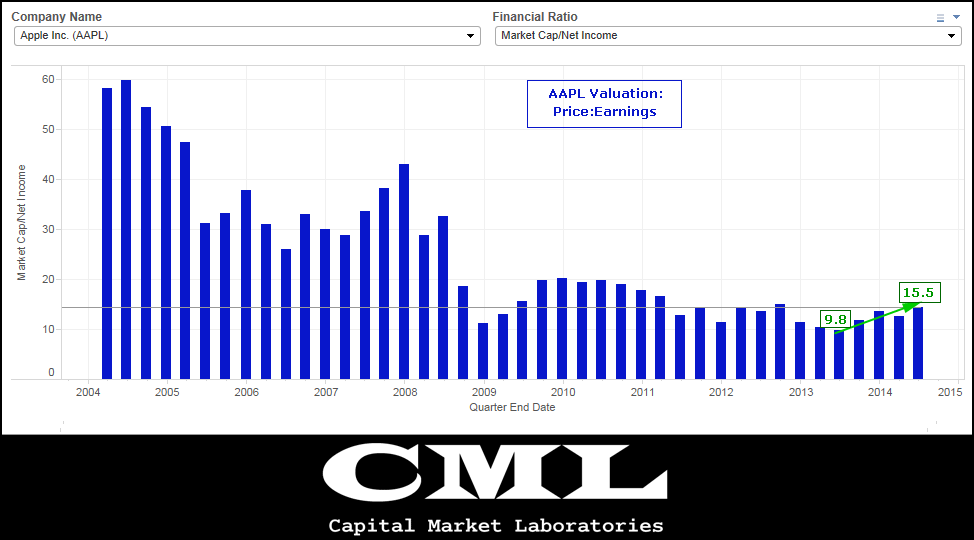
------> Do this analysis yourself: Capital Market Laboratories
Valuation: Comp to Peers
I took a look at all market caps in the US > $100B and charted them with revenue on the x-axis and Price to Sales on the y-axis. We can see that AAPL has huge revenue (far to the right), but it certainly isn't priced to huge growth relative to peers. This doe make sense, but is interesting to actually visualize. Any expansion (or shrinkage) in the Price to Sales equilibrium value will explicitly be reflected in the stock price (duh).
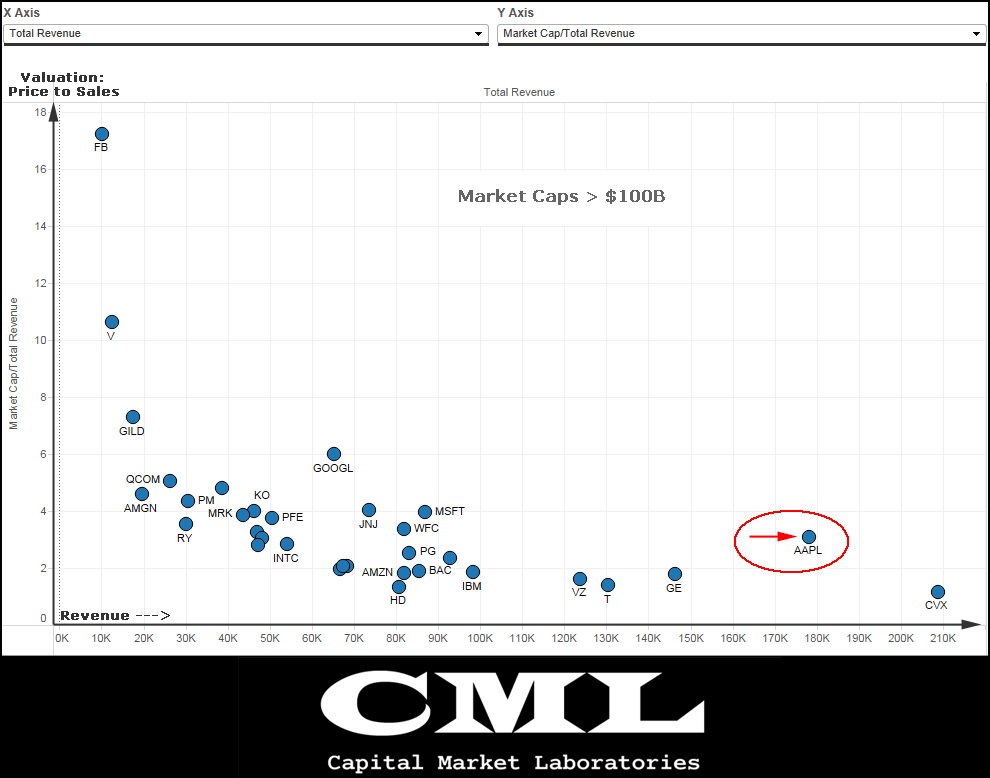
Gross Margin % vs Revenue: Comp to Peers
I took a look this time at all tech firms above $40B in market cap and charted revenue on the x-axis and gross margin % on the y-axis. We can see AAPL has the largest revenue by a lot, and that size has held down gross margin % a bit. Granted,they produce hardware and many of these other firms do not, so this sin;t a great peer group, but it is one that has relevance in a broader picture of technology.
The point: Even a little move in AAPL gross margin % will have a huge impact on earnings.
Watch. That. Number.
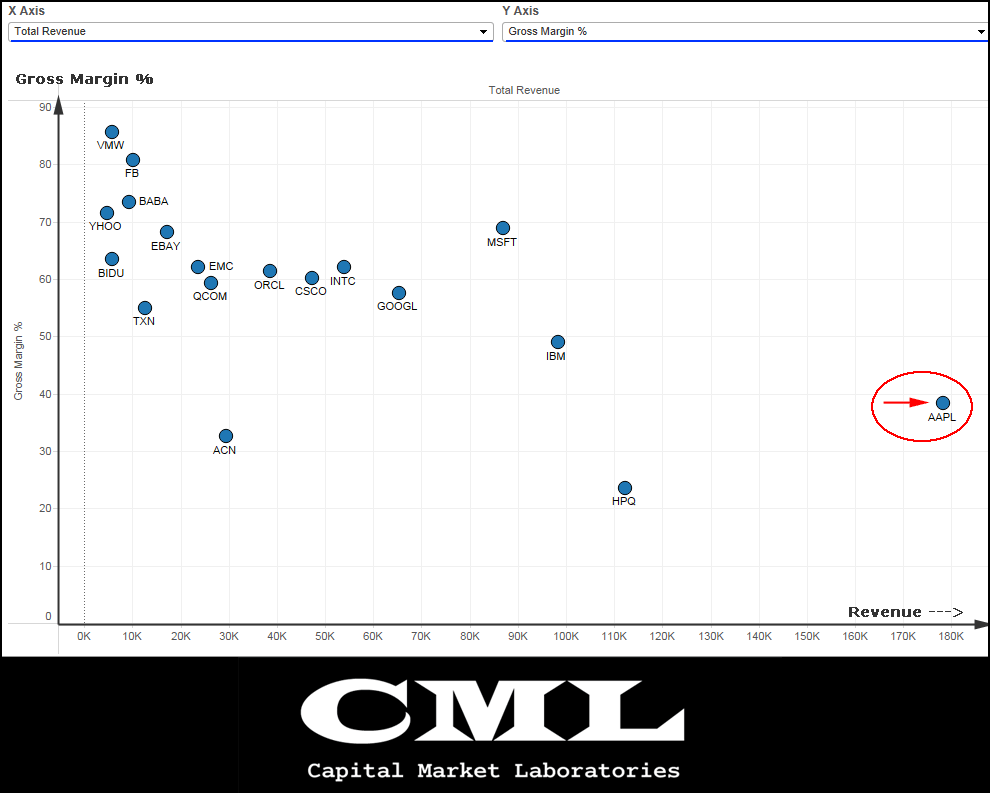
------> Do this analysis yourself: Capital Market Laboratories
Effective Tax Rate
This goes straight to net income, but AAPL has "managed" their effective rate and dropped it from 32% to now 26%.
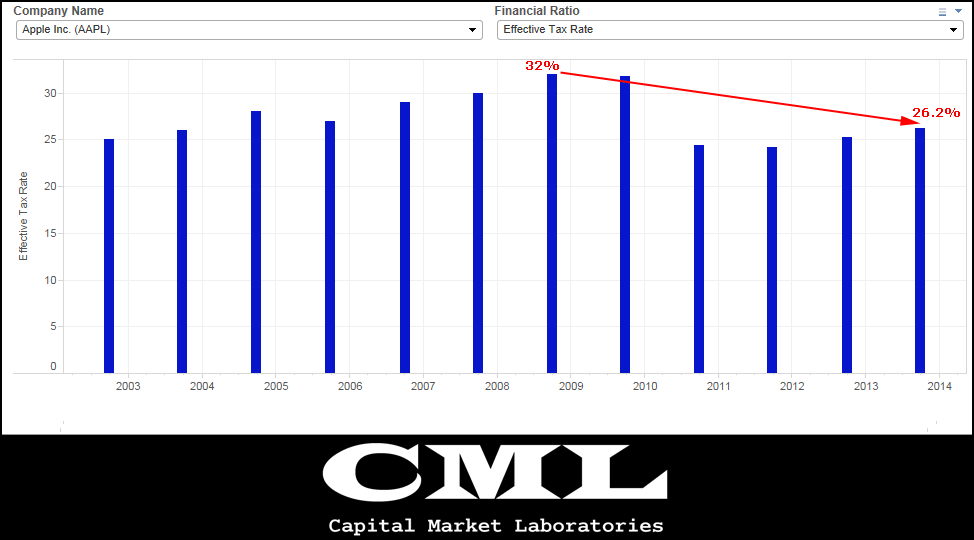
OK... now you know what to look for when earnings come out. Let's next look at the risk in those numbers.
Let's turn to the IV30™ chart in isolation, below.
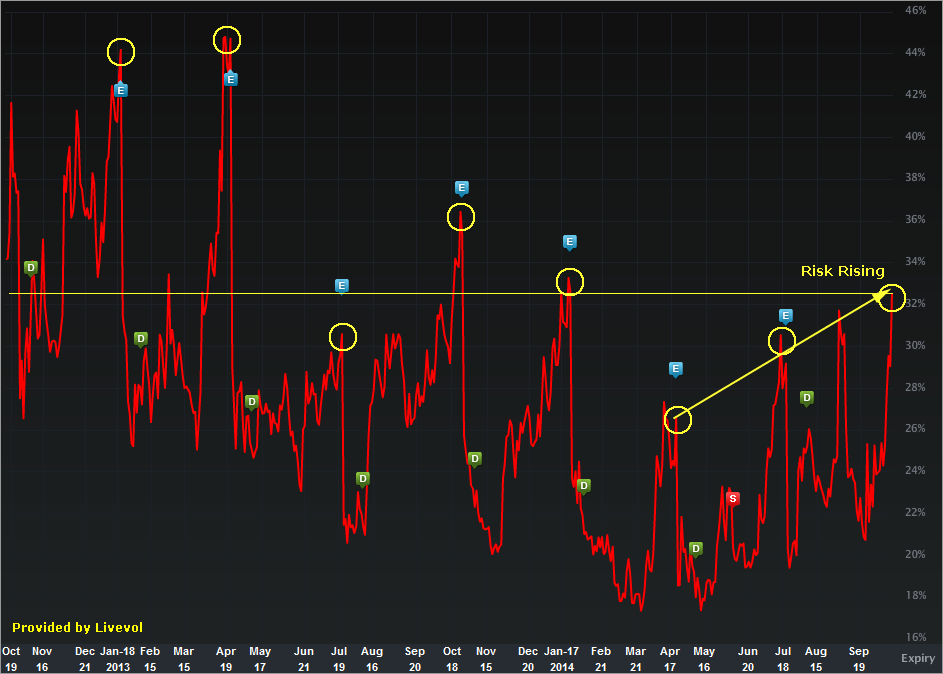
Provided by Livevol
The implied volatility is the forward looking risk in the equity price as reflected by the option market (IV30™ looks forward exactly 30 calendar days).
In English, the red curve is the risk in future stock price movement. The blue "E" icons represent earnings events, and we can see that in the last three consecutive cycles (this quarter included), risk has been rising for AAPL. Again, this makes sense -- iPhne 6 and PhoneGate happened. The market is going down, AAPL is staying up and VIX is exploding.
There could be a hyper reaction to unusual (unexpected) numbers in this earnings release.
Finally, the Options Tab is included below to see explicit risk pricing.
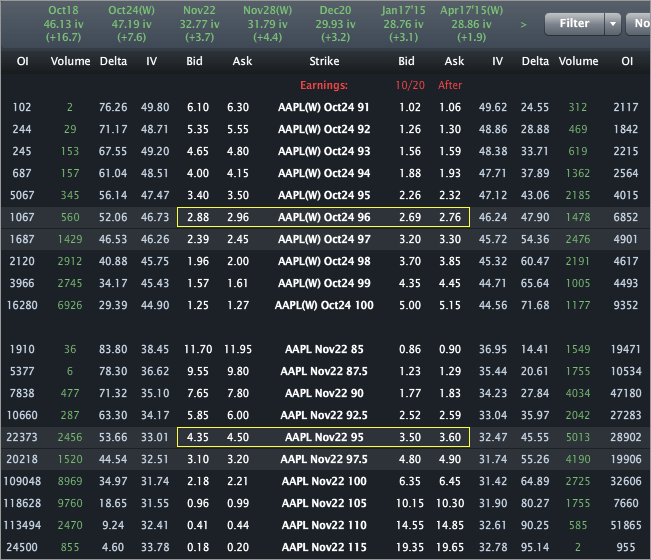
Provided by Livevol
Using the at-the-money (ATM) straddle we can see that the option market reflects a price range of [$90.50, $101.50] by the end of trading on Oct 24th.
That same pricing for November options (end of trading on Nov. 21st) is [$87, $103].
- If you believe the stock will be outside that range on expiry or any date before then, then you think the volatility is too low.
- If you believe that range is too wide, and that the stock will definitively be in that range on expiration, then you think volatility is too high.
- If you're not sure, and can make an argument for either case, then you think volatility is priced just about right.
This is trade analysis, not a recommendation.
Follow @OphirGottlieb
Tweet
Legal Stuff:
Options involve risk. Prior to buying or selling an option, an investor must receive a copy of Characteristics and Risks of Standardized Options. Investors need a broker to trade options, and must meet suitability requirements.
The information contained on this site is provided for general informational purposes, as a convenience to the readers. The materials are not a substitute for obtaining professional advice from a qualified person, firm or corporation. Consult the appropriate professional advisor for more complete and current information. I am not engaged in rendering any legal or professional services by placing these general informational materials on this website.
I specifically disclaim any liability, whether based in contract, tort, strict liability or otherwise, for any direct, indirect, incidental, consequential, or special damages arising out of or in any way connected with access to or use of the site, even if I have been advised of the possibility of such damages, including liability in connection with mistakes or omissions in, or delays in transmission of, information to or from the user, interruptions in telecommunications connections to the site or viruses.
I make no representations or warranties about the accuracy or completeness of the information contained on this website. Any links provided to other server sites are offered as a matter of convenience and in no way are meant to imply that I endorse, sponsor, promote or am affiliated with the owners of or participants in those sites, or endorse any information contained on those sites, unless expressly stated.


Interesting that the risk is "aimed" downward. AAPL priced at $97.54 at EOD today, suggesting $10.50 (~10.76%) of perceived potential downside and only $5.46 (~5.59%) of perceived potential upside by the November date. Thats a 2:1 imbalance. So is the market pricing things right or wrong? Everyone thinks all the good news is priced in. What if margins surprise to the upside (say 41-42%, with next quarter guidance of >45%? As you mentioned, that would make a big difference. Could be a rude awakening, albeit muted by the markets current fear antics.
ReplyDeleteCould you walk through how you calculated the price range (90.5 - 101.5, 87 - 103) for a noob? Much appreciated!
ReplyDeleteHow can you tell based on the options chain etc what the expected trading range is likely to be on the Oct and Nov strikes? I know its probably elementary but i am trying to learn. Thanks :)
ReplyDeleteTake the at-the-money (ATM) options, in this case the $96 strike in Oct 24th weekly options, Add the calls and puts together: = ~$5.50.
DeleteRange = [Strike - $5.50, Strike + 5.50]